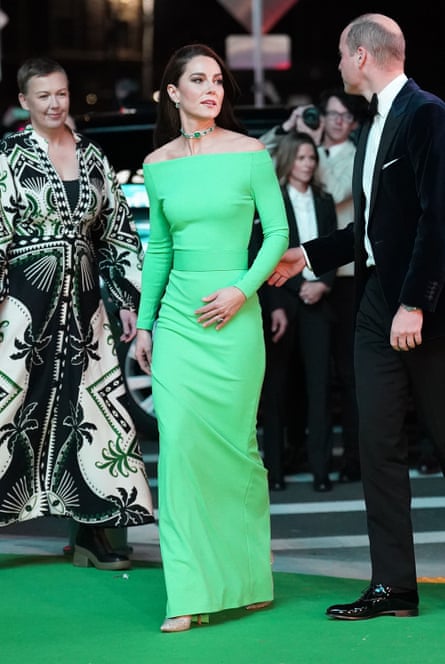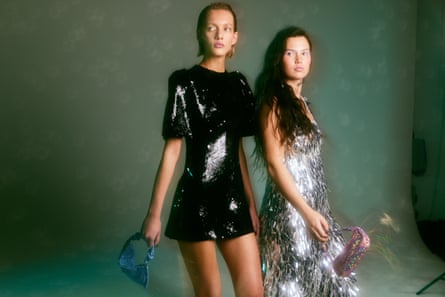
We have become used to staying in strangers’ homes via Airbnb, borrowing books via Kindle and using pay-as-you-drive car sharing clubs such as Zipcar to nip to Ikea but, until recently, renting clothes has been a relatively novel experience.
This could all be about to change, as a slew of brands and retailers move to make clothing rental a far more viable option for everyday customers. On the high street, H&M has introduced a rental section to its revamped Regent Street shop in London, while M&S recently announced it is expanding its offering on the rental platform Hirestreet, through which it first began renting out items a year ago. LK Bennett, John Lewis and Jigsaw have also started offering customers the option to borrow, rather than buy, online.
Elsewhere, luxury online shop MatchesFashion has just launched an edit of designer partywear: a chainmail dress from Paco Rabanne that retails for £2,500 can be rented for four days for £219. Instead of buying meme-worthy crisp packet and chocolate bar bags for £995 from British accessories brand Anya Hindmarch, you can borrow them for £23 a day.
Celebrities are slowly embracing this more circular approach to fashion, too. Earlier this month, the Duchess of Cambridge wore a lime green Solace dress to the Earthshot Prize in Boston, rented from the platform Hurr for £74, rather than bought for £350. The actor Priyanka Chopra Jonas and reality TV star Kourtney Kardashian are also fans of rental fashion, as is former Number 10 resident Carrie Johnson. Her entire 2019 G7 wardrobe was reportedly leased while her wedding gown, by Greek designer Christos Costarellos, cost £45 a day from the rental site My Wardrobe HQ.
To date, the biggest players in the UK fashion rental market – including Hurr (a website) and By Rotation (an app) – have focused on providing an edit of high-end labels and what the fashion industry likes to call “sweet-spot brands”, such as Ganni and Rixo London, whose retail price point falls around the £250 mark. If you’ve been to a wedding in the last year, at least one guest is guaranteed to have been wearing a printed silky dress from this cohort. The rental price is typically about 10% of the RRP, and leases are usually four days. Generally, there are options to add a small damage protection fee, too, to cover, say, a wine spillage or a broken zip. High-street rentals start from as little as £7 a day.
The UK loves to shop for clothes. According to the environmental group Wrap, one in eight people buy a new item of clothing each week while wardrobes hold 1.6 bn unworn garments. A quarter of the clothes we own haven’t been worn in a year.
Until recently, the rental market had been largely fuelled by Gen Z, which is generally passionate about the environment and workers’ rights but still wants to have new looks to show off on social media. However, with the cost of living crisis heightening, consumers are feeling increasingly pushed to choose between sustainability and price.
With this in mind, 2022 is proving to have been a pivotal time for the fashion rental industry. According to the data analytics company GlobalData, the UK rental apparel market is forecast to be worth £142m by the end of the year, with growth of 62% in 2023 and 164% predicted in the following years to 2026. No wonder the high street is keen to get in on the action, too.

Cara, a 30-year-old finance worker from London, says she prefers to rent high street brands as it’s more cost effective. “I’ve looked at the more expensive rental sites – but, for £180, I could buy a dress rather than rent one. Renting high street brands saves me money.”
Rental tends to work in a number of ways. The most common is peer-to-peer lending, where people borrow clothes directly from one another. The platform charges the lender commission, typically about 10-15%, to host their wardrobe.
There’s also a service known as “white label” that is becoming increasingly popular. This is where a retailer, such as Jigsaw, uses a rental platform (in Jigsaw’s case, My Wardrobe HQ) to carry out all the logistics but makes it appear as if the customer is renting it directly from its site. It’s an easy way of attracting customers who might otherwise be intimidated by a specific rental site. Instead of having to trawl through multiple brands, they can browse on the site of a brand they are already familiar with.
Victoria Prew, founder and CEO of Hurr, explains that her company takes a hybrid approach. Alongside a vast peer-to-peer community (items must be less than two years old and retail for more than £120) Hurr does all the faffy, complex bits – organising returns, cleaning and reshipping each item – for more than 130 brands, including Hugo Boss. It also powers rental for retailers including Selfridges, John Lewis and, most recently, Matches Fashion. “We’re up 700% in terms of year-on-year revenue,” she says.

With slick branding and glamorous advertising campaigns, these platforms personify the Gen Z customer to whom they hope to appeal: think feather-trimmed mini dresses from 16 Arlington, towering heels from Prada and teeny tiny bags from Jacquemus designed for garnering likes on Instagram. It feels like browsing in a luxury store, rather than rummaging through someone’s castoffs.
The high-street champions, such as Hirestreet, take a more humble approach. Founder and CEO Isabella West says she was inspired to set up the business after realising there was a gap in the market for a lower priced rental option. Alongside M&S, you’ll find British high street staples including French Connection and River Island. There’s also dedicated tall, petite and curve ranges with sizes spanning a UK 4 to a UK 32.
“We are not the people to come to when you have £100 to rent a £1,000 dress,” says West. “Our most popular offering at the moment is any two dresses for £30. The reason we are doing that offer is that our customers told us that is the amount they would typically spend in a store such as H&M, to get something like a Christmas party look.”
The cost of living is clearly a driving force for Hirestreet’s popularity. Launched in 2018, it now has more than 1.5 million users. It doesn’t offer a rolling subscription; instead, users choose to rent pieces from four to 30 days. The people who have joined since January have typically rented 10 times each over the past 10 months.
“People might have allocated 5% of their disposable income to fashion [in the past] but now they need an additional 3% for essentials, such as groceries,” says West. “They still have the same number of events to go to but they’ve got less to spend. Whatever behaviour they have towards being sustainable is going to be challenged.”
While most platforms focus on clothes for events such as parties and weddings, for its latest Hirestreet offering, M&S has zoned in on casualwear with the launch of six capsule collections given names such as Autumn Warmth and Comfy Cool, and featuring hoodies, puffer jackets and straight leg jeans. Prices range from £39 for five days, up to £59 for 30 days rental.

“The rental market has been widely associated with formal events but we know 35% of M&S customers are interested in renting for a casual event such as a weekend away,” says Richard Price, managing director of clothing and home at M&S.
By curating bestselling products into themed collections, M&S aims to show “how staple items can be used to style up to 10 separate outfits, perfect for making budgets go further,” says Price. The City Knits capsule, which includes wide-legged jersey trousers, a fleece gilet and a Breton striped jumper, has proved to be most popular, and is booked out in most sizes until January.
Alongside renting occasionwear, Cara says she has more recently started renting staple items, such as T-shirts, too. “At the moment, I’m having to think more shrewdly about every purchase I make. Even buying basics adds up and, given the quality and the amount I’d wear them, they wouldn’t last me past winter. Renting is more sustainable but I still get the instant gratification of having something new to wear every weekend.”
While all rental sites make claims towards sustainable fashion, the reality of this is hard to gauge. Rental might be a way to avoid buying new, but it also necessitates an endless cycle of packaging, transport, and cleaning.
Hurr is a certified B Corporation, meaning it meets verified standards relating to its social and environmental performances. Its efforts towards sustainability include an exclusive partnership with Oxwash, a chemical-free dry cleaner, alongside courier bags that can be reused on average 30 times. However, this only relates to the items Hurr manages directly.
For peer-to-peer, the lenders take care of the garment’s journey themselves, making it even more complicated when it comes to claims of reducing the quantity of clothes in the fashion cycle. Some lenders are specifically buying items to rent out with top lenders making up to £20k a year. Renting as a sustainable side hustle? The lines are ever blurred.
Vanessa, a beauty worker from London recently made £1,000 in a week and is aiming to “maintain this momentum” in the lead up to the festive season. She says she focuses on “evening gowns, sparkly stuff and things with feathers, pieces that you’ll wear once.” Her top performing brands include The Vampire’s Wife, 16Arlington and Alessandra Rich. “For most people, it’s hard to justify those price tags,” she says, with retail prices averaging around the £1,500 mark. “[But] you can pay a fraction of the retail price in rental from me.”
While Hirestreet has its own warehouse in Glasgow where it says it minimises the use of chemical cleaners, alongside trying to reduce plastic waste in items such as coat hangers, West believes the biggest impact rental can have is by changing consumer behaviour, especially the “buy once, wear once” mentality.
“Ninety per cent of the carbon footprint of an item happens in the production phase. By renting an item you have the opportunity to split the production produced carbon over every person that is wearing it,” she says.

In a tough economic climate, rental is providing a huge opportunity for retailers, too. Cara says that M&S is a brand she would have overlooked before renting its clothes via Hirestreet. It was a pair of leather trousers, hired for £32 rather than bought for £179, that changed her mind. Hirestreet also often lets you rent multiple sizes, and any unworn items earn you credit that can be used on future rentals.
In 2020, Oasis closed all its stores after administrators said they had been unable to secure a rescue deal for the fashion chain. Its stock has since been sold to the restructuring firm Hilco. This summer, on Hirestreet, it became one of the site’s most popular brands.
“A lot of our customers search by occasion rather than by brand,” says West. “We give them an edit of about 50 recommended garments. They are looking at a style, rather than a label. They may not have chosen to go to that brand’s website so we can serve as the perfect reintroduction to a brand.”
With reports of declining town centres and store closures could rental be a way of future-proofing highstreet labels in a volatile market? With many brands booked out across the various sites for weeks at a time, perhaps it is the solution the industry has been looking for. Only time, and social media tags, will tell.
For designer name-droppers
Featuring options from fashion insider favourites including The Row, here you rent designer pieces for up to 14 days. There’s also a subscription model offering two to four pieces each month and collaborations with Harrods, Burberry and Tommy Hilfiger.

For channelling your favourite influencer
Operating as a marketplace for lenders and renters, here you can browse the wardrobes of more than 200,000 users, including influencers with clout. Follow your favourites and share or ask for styling tips.
For mothers-to-be
Featuring both maternity and non-maternity brands, you can rent by both “bump stage” or occasion. Everything from wafty dresses for a “babymoon” to nursing bras in the “home from hospital” edit have been thought of.
For fabric fiends
A London-based womenswear brand that produces sustainably focused pieces in EU factories. Think organic cotton jeans and recycled knitwear. Rent pieces in a size UK 6-18 for up to two weeks.


